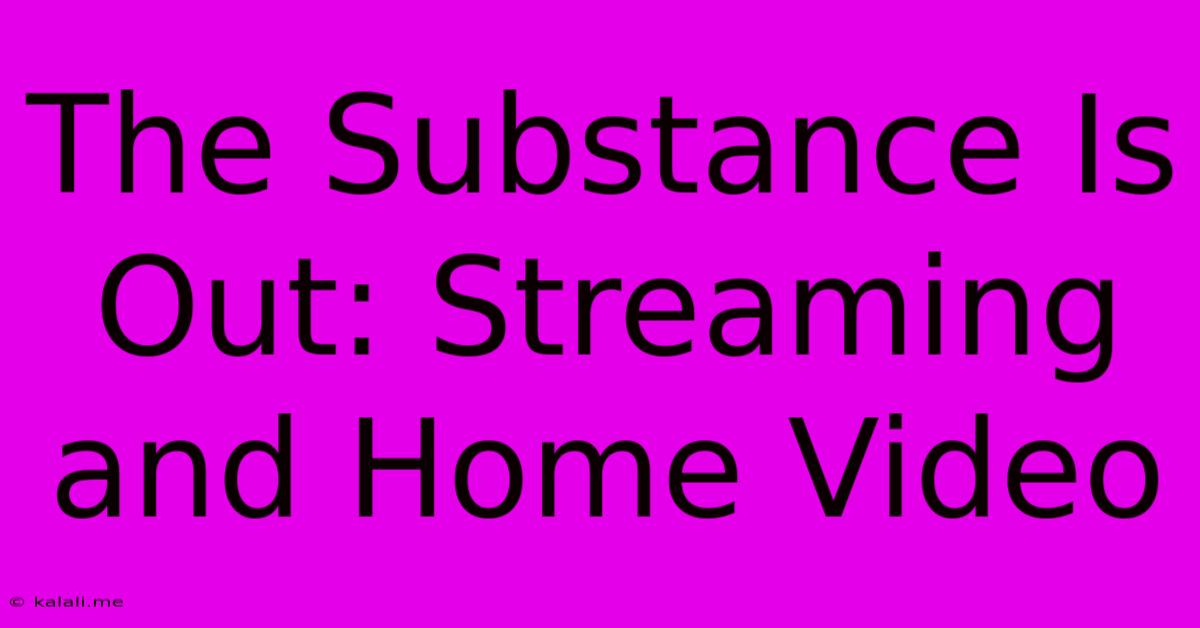The Substance Is Out: Streaming And Home Video
Kalali
Jan 09, 2025 · 4 min read

Table of Contents
The Substance Is Out: Streaming and Home Video – A Paradigm Shift in Entertainment Consumption
The way we consume entertainment has undergone a seismic shift. Gone are the days of solely relying on cinemas and physical media; streaming and home video have revolutionized how we access movies and TV shows, creating a landscape as diverse and dynamic as ever before. This article delves deep into this transformative evolution, exploring the impact of streaming services, the enduring appeal of home video, and the future of entertainment consumption.
The Rise of Streaming: Convenience and Choice Reign Supreme
Streaming services have undeniably become the dominant force in entertainment consumption. Platforms like Netflix, Disney+, HBO Max, Amazon Prime Video, and Hulu offer vast libraries of content, catering to diverse tastes and preferences. The convenience factor is paramount: access to thousands of movies and TV shows at your fingertips, anytime, anywhere, with no physical media to manage.
The Advantages of Streaming:
- Accessibility: Watch what you want, when you want, on virtually any device.
- Affordability: Subscription models often provide more value than individual purchases, especially for frequent viewers.
- Curated Content: Algorithmic recommendations cater to individual viewing habits, offering personalized suggestions.
- Original Programming: Streaming giants invest heavily in original series and films, attracting top talent and creating exclusive content.
- Global Reach: Streaming platforms transcend geographical boundaries, exposing viewers to diverse cultures and storytelling.
The Challenges of Streaming:
- Subscription Fatigue: The proliferation of streaming services has led to "subscription fatigue," with consumers struggling to afford multiple subscriptions.
- Content Fragmentation: Popular shows are spread across different platforms, making it difficult to find everything you want in one place.
- Algorithm Bias: Recommendation algorithms can create echo chambers, limiting exposure to diverse genres and perspectives.
- Data Privacy Concerns: Streaming services collect vast amounts of user data, raising concerns about privacy and surveillance.
- Internet Dependency: Access to streaming requires a reliable internet connection, excluding those with limited or no internet access.
The Enduring Appeal of Home Video: Nostalgia and Ownership
Despite the rise of streaming, home video remains a significant part of the entertainment landscape. Physical media like Blu-ray discs and even DVDs still hold a strong appeal, especially for cinephiles and collectors.
Why Home Video Still Matters:
- Ownership: Unlike streaming, home video offers the tangible satisfaction of owning a physical copy of your favorite movies.
- Collectibility: Limited edition releases, special features, and packaging make home video an attractive proposition for collectors.
- Uninterrupted Viewing: No buffering, no internet dependency – simply insert the disc and enjoy.
- Superior Audio/Visual Quality: In some cases, home video offers superior audio and visual quality compared to streaming.
- Nostalgia: For many, physical media evokes a sense of nostalgia, reminding them of a simpler time.
The Future of Home Video:
While the dominance of streaming is undeniable, the home video market is adapting. 4K Ultra HD Blu-ray discs offer superior visual fidelity, while special editions and collector’s sets continue to appeal to enthusiasts. The future likely lies in a blend of physical and digital ownership, offering consumers the best of both worlds.
The Convergence of Streaming and Home Video: A Symbiotic Relationship
The relationship between streaming and home video is not one of pure competition but rather a complex interplay. Streaming services often offer digital rentals or purchases of movies, bridging the gap between subscription-based content and individual ownership. Furthermore, some streaming platforms offer downloadable content, allowing users to watch offline, mimicking the convenience of physical media. This convergence suggests a future where both methods of entertainment consumption coexist, offering complementary rather than conflicting experiences.
The Future of Entertainment Consumption: A Multifaceted Landscape
Predicting the future of entertainment consumption is a challenging task, but some trends are clear. The dominance of streaming is likely to continue, but the landscape will remain multifaceted. We can expect:
- Increased personalization: AI-powered recommendations and curated content will become even more sophisticated.
- Enhanced interactivity: Interactive movies and TV shows will offer viewers greater control over the narrative.
- Immersive experiences: Virtual reality and augmented reality will create new ways to consume entertainment.
- Hybrid models: The convergence of streaming and home video will continue, blurring the lines between subscription services and individual ownership.
- Focus on quality: As the market becomes saturated, the emphasis will shift towards high-quality content and unique viewing experiences.
Conclusion: Embracing the Evolution
The shift towards streaming and home video represents a fundamental change in how we consume entertainment. While streaming services have undeniably disrupted the industry, home video retains a loyal following. The future of entertainment consumption lies in embracing this multifaceted landscape, leveraging the advantages of both streaming and home video to create a rich and diverse entertainment experience. The substance is out – and the possibilities are endless.
Latest Posts
Latest Posts
-
How Many Teaspoons In A Pound Of Sugar
Jul 12, 2025
-
How Do You Pass Level 12 On Bloxorz
Jul 12, 2025
-
How Far Is 0 4 Miles To Walk
Jul 12, 2025
-
What Is 20 Percent Of 800 000
Jul 12, 2025
-
Words That Start With Y In Science
Jul 12, 2025
Related Post
Thank you for visiting our website which covers about The Substance Is Out: Streaming And Home Video . We hope the information provided has been useful to you. Feel free to contact us if you have any questions or need further assistance. See you next time and don't miss to bookmark.